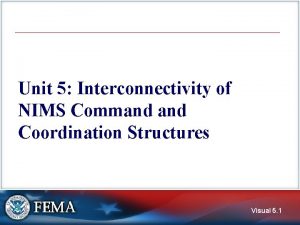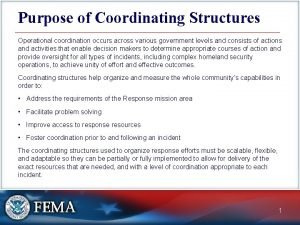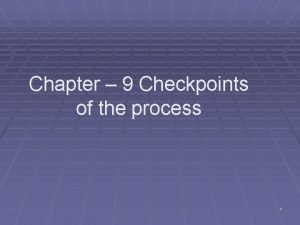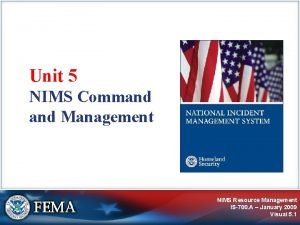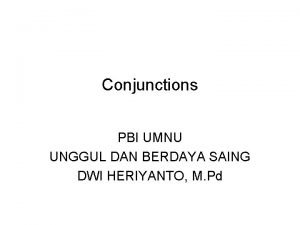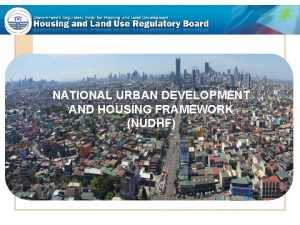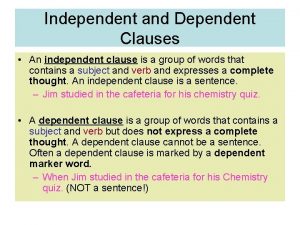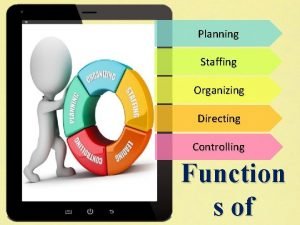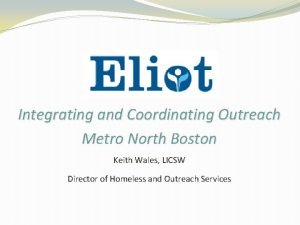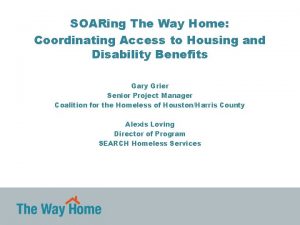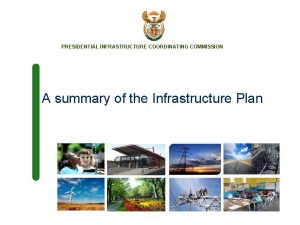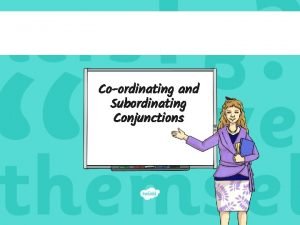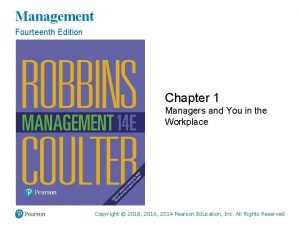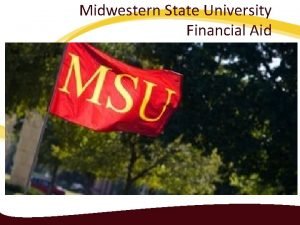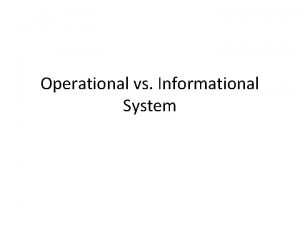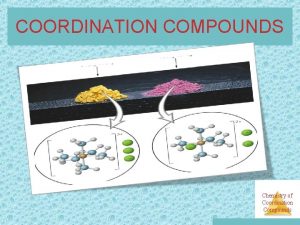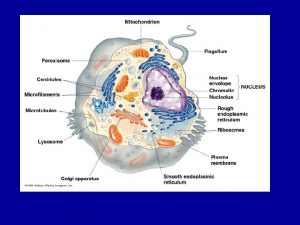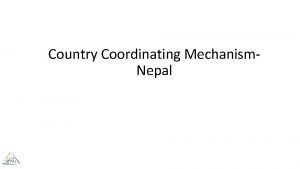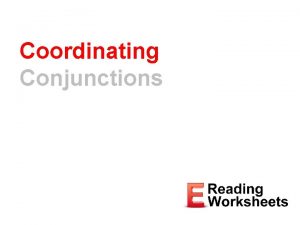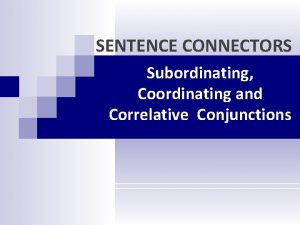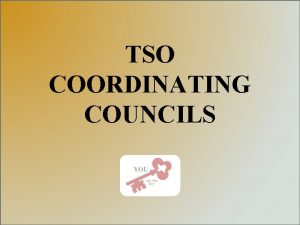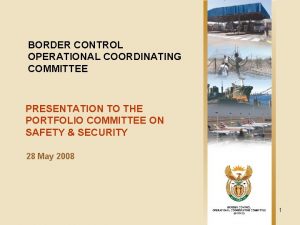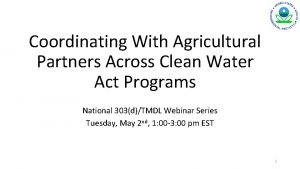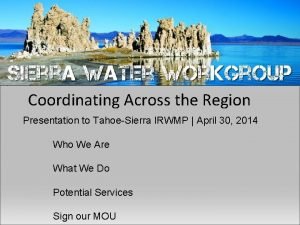Purpose of Coordinating Structures Operational coordination occurs across



















- Slides: 19

Purpose of Coordinating Structures Operational coordination occurs across various government levels and consists of actions and activities that enable decision makers to determine appropriate courses of action and provide oversight for all types of incidents, including complex homeland security operations, to achieve unity of effort and effective outcomes. Coordinating structures help organize and measure the whole community’s capabilities in order to: • Address the requirements of the Response mission area • Facilitate problem solving • Improve access to response resources • Foster coordination prior to and following an incident The coordinating structures used to organize response efforts must be scalable, flexible, and adaptable so they can be partially or fully implemented to allow for delivery of the exact resources that are needed, and with a level of coordination appropriate to each incident. 1

Private-Sector Coordinating Structures When catastrophic incidents put a premium on the restoration of complex supply chains (especially for essential products and services needed for response efforts and stabilization of the economy), private sector coordination and assets are vital for public health and safety, the economy, and national security. The private sector can also help government agencies prioritize support missions (e. g. , debris removal) to facilitate business and infrastructure response operations. 2

Local Coordinating Structures and Operational Planning At the local level, coordinating structures are usually composed of entities within specific functional areas, such as public works, law enforcement, emergency medical services, and fire departments. On-scene integration among these structures may occur at incident command posts (ICPs) and more frequently at one or more local EOCs. Emergency responders at all levels of government use NIMS and ICS structures to manage and support response operations. 3

Local Emergency Operations Center If the local Incident Commander determines that additional resources or capabilities are needed, requirements are relayed to the local emergency operations center (EOC)—the physical location where multiagency coordination typically occurs and where a variety of local coordinating structures come together to solve problems. The EOC: • Helps form shared situational awareness of the incident • Relieves on-scene command of the burden of external coordination • Secures additional resources to help meet response requirements At the local level, Incident Management coordination also includes Multiagency Coordination Groups (MAC Groups). 4

State Coordinating Structures and Operational Planning While the local incident command structure directs on-scene incident management activities and maintains command control of on-scene incident operations, state EOCs are activated as necessary to support local EOCs and to help ensure that responders have the resources they need to conduct response activities. State, tribal, territorial, and insular area EOCs also provide a common location for coordination of state/tribal/territorial/insular area-and in some cases, federal--support to local EOCs and/or incident personnel. The Tribal Assistance Coordination Group (TAC-G) is a MAC Group that assists federally recognized tribes during emergencies and disasters and provides information and technical assistance for tribal emergency management programs in coordination with federal partners. 5

Introduction to Federal Operations Centers When an incident occurs that exceeds, or is anticipated to exceed, local or state resources—or when an incident is managed by Federal departments or agencies acting under their own authorities—the Federal Government may use the management structures described within the National Response Framework. Additionally, the Federal Government may use supplementary or complementary plans to involve all necessary department and agency resources to organize the Federal response and ensure coordination among all response partners. Many of the arrangements by which departments and agencies participate are defined in the ESF Annexes, coordinated through pre-scripted mission assignments in a Stafford Act response, formalized in interagency agreements, or described in the National Response Framework supplementary plans. The following sections describe Federal support operations center. 6

Federal Operations Centers DHS/FEMA Overall, there are 9 Field Operations Centers that are organized between DHS/FEMA, FBI, and other agencies. First, we will review 6 centers that work under DHS/FEMA • Cybersecurity and Infrastructure Security Agency (CISA) • Integrated Operations Coordination Center (CIOCC • National Operations Center (NOC) • National Response Coordination Center (NRCC • Regional Response Coordination Center (RRCC) • Joint Field Office (JFO) 7

Federal Operations Centers: FBI Next, are two centers that work under FBI: • Strategic Information and Operations Center (SIOC) • Joint Operation Center (JOC) 8

Federal Operations Centers: Other Agencies Finally, the following 2 centers work under other agencies which are: • National Military Command Center (NMCC) • National Policy - The National Security Council (NSC) 9

Knowledge Review 1 Based on the information presented, let's take a few minutes to discuss how do coordination structures help organize and measure the whole community's capabilities? Be prepared to discuss your answer. 10

Unified Coordination Unified coordination is the term used to describe the primary state/tribal/territorial/insular area/federal incident management activities conducted at the incident level. Unified coordination is typically directed from a Joint Field Office (JFO), a temporary federal facility that provides a central location for coordination of response efforts. The Unified Coordination Group (UCG) is composed of senior leaders representing state, tribal, territorial, insular area and federal interests and, in certain circumstances, local jurisdictions, the private sector, and NGOs. Federal Interagency Operational Plans (FIOPs) describe how the Federal government aligns resources and delivers core capabilities to reach our shared National Preparedness Goal. To learn more about Response FIOP, please read the notes. To learn more about Unified Coordination Staff Description, please read the notes. 11

ESF Definitions Coordination of Federal incident response is accomplished through Emergency Support Functions (ESFs). ESFs are organized groups of government and private-sector entities that provide personnel, supplies, facilities, and equipment. Federal ESFs bring together the capabilities of Federal departments and agencies and other national-level assets that work together to deliver core capabilities and support an effective response. Communities, states, tribal governments, regions, and other Federal departments and agencies may also use the ESF structure, and they are encouraged to work closely with Federal ESFs at the incident, regional, or Headquarters levels if they are activated. Watch the following video to learn more about ESFs. 12

ESF List ESFs are not solely attributed to any one organization, nor are they mechanisms for executing an agency's statutory authorities. Below is a list of Emergency Support Functions. Read the notes section to learn more about each one. Emergency Support Functions ESF #1 Transportation ESF #9 Search & Rescue ESF #2 Communications ESF #10 Oil & Hazardous Materials Response ESF #3 Public Works & Engineering ESF #11 Agriculture & Natural Resources ESF #4 Firefighting ESF #12 Energy ESF #5 Information & Planning ESF #13 Public Safety & Security ESF #6 Mass Care, Emergency Assistance, Temporary Housing & Human Assistance ESF #14 Cross-Sector Business and Infrastructure ESF #7 Logistics ESF #15 External Affairs ESF #8 Public Health & Medical Services 13

Community Lifelines Means, Ways, Ends The interrelationship of Emergency Support Functions (ESF), Core Capabilities, and lifelines can be thought of in terms of means, ways, and ends. Means: ESFs and other organizing bodies—the means—are the way we organize across departments and agencies, community organizations, and industries to enhance coordination and integration to deliver the Response Core Capabilities. Through these ESFs, government and private-sector entities provide the personnel, supplies, facilities, and equipment needed for Response. Ways: Response Core Capabilities describe the grouping of response actions—the ways —that can be taken to stabilize and re-establish the lifelines. FEMA executes Lines of Effort (LOE) to operationalize the Core Capabilities (the ways) for response and recovery planning and operations. Ends: Lifelines describe the critical services within a community that must be stabilized or re-established—the ends—to alleviate threats to life and property. Read more about the Lifeline Toolkit (www. fema. gov/medialibrary/assets/documents/177222). 14

ESF and Community Lifelines Example actions that an ESF may take in support of stabilizing the Health and Medical Lifeline during incident response operations: ESF Example Supporting Actions or Capabilities ESF #1 Transportation Coordinate the opening of roads and manage aviation airspace for access to health and medical facilities or services. ESF #2 Communications Provide and enable contingency communications required at health and medical facilities. ESF #3 Public Works & Engineering Install generators and provide other temporary emergency power sources for health and medical facilities. ESF #4 Firefighting Coordinates federal firefighting activities and supports resource requests for public health and medical facilities and teams. ESF #5 Information & Planning Develop coordinated interagency crisis action plans addressing health and medical issues. ESF #6 Mass Care, Emergency Assistance, Temporary Housing, & Human Assistance Integrate voluntary agency and other partner support, including other federal agencies and the private sector, to resource health and medical services and supplies. ESF #7 Logistics Provide logistics support for moving meals, water, or other commodities. ESF #8 Public Health & Medical Services Provide health and medical support to communities, and coordinate across capabilities of partner agencies. ESF #9 Search & Rescue Conduct initial health and medical needs assessments. ESF #10 Oil & Hazardous Materials Response Monitor air quality near health and medical facilities in close proximity to the incident area. ESF #11 Agriculture & Natural Resources Coordinate with health and medical entities to address incidents of zoonotic disease. ESF #12 Energy Coordinate power restoration efforts for health and medical facilities or power-dependent medical populations. ESF #13 Public Safety & Security Provide public safety needed security at health and medical facilities or mobile teams delivering services. ESF #14 Cross-Sector Business and Infrastructure Be informed of and assess cascading impacts of health or medical infrastructure or service disruptions, and deconflict or prioritize cross-sector requirements. ESF #15 External Affairs Conduct public messaging on the status of available health and medical services or public health risks. 15

Knowledge Review 2 What is the Tribal Assistance Coordination Group (TAC-G)? 16

Conclusion The National Response Framework (NRF) provides foundational emergency management doctrine for how the Nation responds to all types of incidents. The NRF is built on scalable, flexible, and adaptable concepts. The whole community should be engaged in examining and implementing the strategy and doctrine contained in the NRF, considering both current and future requirements in the process. Remember, Whole Community includes: The private sector; NGOs; local, state, tribal, territorial, and insular area governments; and the Federal Government, as well as other response entities. The whole community remains firm in its commitment to safeguard itself against its greatest risks, now and in the future. Through whole community engagement, the Nation will continue to improve its preparedness to face all emergencies or disaster challenges that may unfold. Visit the website to access the National Preparedness Resources Library (https: //www. fema. gov/national-preparedness-resource-library). 17

Course Completion You have now completed all of the lessons. Prior to taking the examination, we recommend that you: • Access and print a summary of the course contents. • Review the National Response Framework (https: //www. fema. gov/national-planning-frameworks) base document. • Complete and pass the final exam. Visit the EMI Final Exam webpage to access the final exam (https: //training. fema. gov/is/sidpiv. aspx? eid=IS 800 d). 18

Course Summary In this course, you’ve learned that the National Response Framework is a guide that details how the nation conducts all-hazards response and that it: • Describes how to manage all-hazards responses for all levels. • Built on scalable, flexible, and adaptable concepts identified in the National Incident Management System (NIMS). • Describes the actions to save lives, protect property and the environment, stabilize communities, and meet basic human needs following an incident. • Describes core capabilities for response and actions required to deliver those capabilities. • Explains how the seven Community Lifelines reduce threats to public health and safety, the economy, and security. 19
 Federal coordinating structures include
Federal coordinating structures include Optical isomerism in octahedral complexes
Optical isomerism in octahedral complexes How do coordination structures help organize and measure
How do coordination structures help organize and measure The initial operational capability milestone occurs
The initial operational capability milestone occurs Nims command is
Nims command is Homologous structure
Homologous structure What are the seven conjunctions
What are the seven conjunctions Nudhf
Nudhf Independent clause with conjunction
Independent clause with conjunction Conjunctive verbs
Conjunctive verbs Function of management
Function of management Coordinating marketing activities
Coordinating marketing activities Coordinating
Coordinating Coordinating
Coordinating Presidential infrastructure coordinating commission
Presidential infrastructure coordinating commission Coordinating and subordinating conjunctions
Coordinating and subordinating conjunctions Management involves coordinating and overseeing
Management involves coordinating and overseeing Conjunction junction whats your function
Conjunction junction whats your function Midwestern state university financial aid office
Midwestern state university financial aid office Thamo grammer
Thamo grammer
